新世纪少儿英语-1-look-lesson-3教学内容
- 格式:ppt
- 大小:4.86 MB
- 文档页数:32
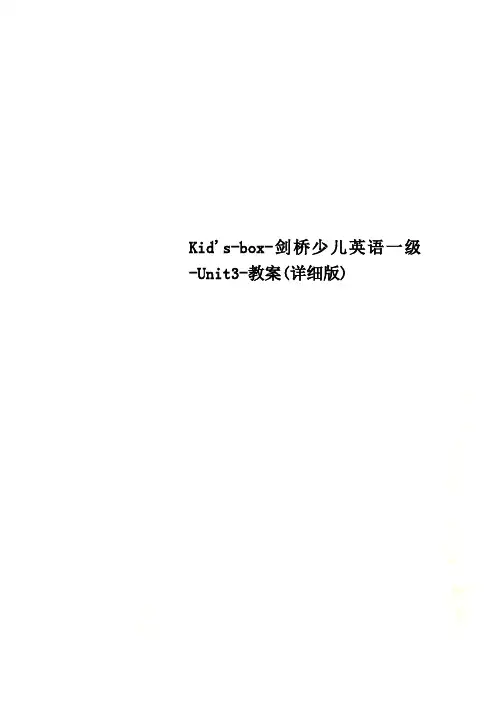
Kid's-box-剑桥少儿英语一级-Unit3-教案(详细版)《剑桥国际少儿英语》第一册教案Unit 3 Favorite toys单元目标语言:语词car, ball, doll, computer, bike, train, black, brown, white, grey, tortoise, two, toys结构What ’s your favorite toy? My favorite toy is … in, on,under, next to, Where ’s your …? Is your (bag) under your (chair)? 单元技能目标: 听 能够听懂问候的常用语,教师和课本上的指令语,玩具,四种颜色,介词的位置,辨别/t/的发音说 能够就玩具的话题进行简单回答,用介词表示方位,说一首有关颜色的歌谣,能唱一首关于介词位置的歌曲 读 能认读出阿拉伯数字写 能正确涂色,能写出数字,能圈出所要选择的项目第一课时 Lesson 1课型 词汇句型教学对象: 小学1-2年级教学目标学习教室中的各种物品的名称,并数出这些物品。
目标语言重点语言car, ball, doll, computer, bike, train, What’s your favoritetoy? My favorite toy is…补充语言Where’s …?复习What’s this? It’s a…Where’s…?教学材料人物单词卡片(1-3,19,33-34),玩具单词卡片(35-40),学校单词卡片(27-32),CD或者磁带,可选:实物教具car, ball, doll, computer, bike, train课堂教学过程(40 mins)建议时间教学步骤教师活动学生活动活动设计意图Warm up / Lead in 5分钟1. 打招呼。
说:Hello, (学生的名字),how are you? 学生回答:I’m fine, thank you. 被问◆回答问题,问候其他人。
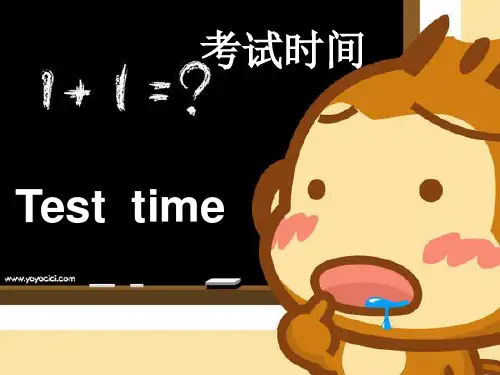
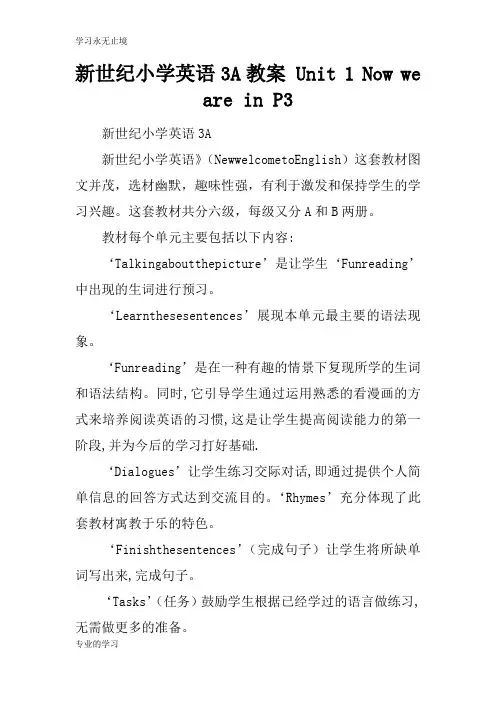
新世纪小学英语3A教案 Unit 1 Now weare in P3新世纪小学英语3A新世纪小学英语》(NewwelcometoEnglish)这套教材图文并茂,选材幽默,趣味性强,有利于激发和保持学生的学习兴趣。
这套教材共分六级,每级又分A和B两册。
教材每个单元主要包括以下内容:‘Talkingaboutthepicture’是让学生‘Funreading’中出现的生词进行预习。
‘Learnthesesentences’展现本单元最主要的语法现象。
‘Funreading’是在一种有趣的情景下复现所学的生词和语法结构。
同时,它引导学生通过运用熟悉的看漫画的方式来培养阅读英语的习惯,这是让学生提高阅读能力的第一阶段,并为今后的学习打好基础.‘Dialogues’让学生练习交际对话,即通过提供个人简单信息的回答方式达到交流目的。
‘Rhymes’充分体现了此套教材寓教于乐的特色。
‘Finishthesentences’(完成句子)让学生将所缺单词写出来,完成句子。
‘Tasks’(任务)鼓励学生根据已经学过的语言做练习,无需做更多的准备。
学生情况分析及改进措施通过二年的英语浸入式学习,学生认知于人际能力伴随语言一起发展,从而充分调动了学生的主动性,学生的英语兴趣不断提高,使英语语言的发展成为课堂中隐性的自然的习得过程。
在两年的浸入式英语学习过程中,班里许多学生可以用英语思维去学习语言,由于教师在课堂上不用母语,因此儿童的英语听力理解发展的很快,并且认读能力也有相应的提高。
并且一些学生在全国及全省英语比赛中取得了优异的成绩,部分学生语言表达能力有了较大提高,在三年级的教学中,我将尽最大努力提高两个班学生的英语会话水平,提高学生整体水平。
在三年级的学习过程中,为了给学生提供更为广阔丰富的语言环境,使孩子听、说能力不断提高,读、写能力随之跟上。
教师应给孩子创设更为轻松的语言习得环境,设计更为丰富多彩的教学活动,让学生自然的交流。
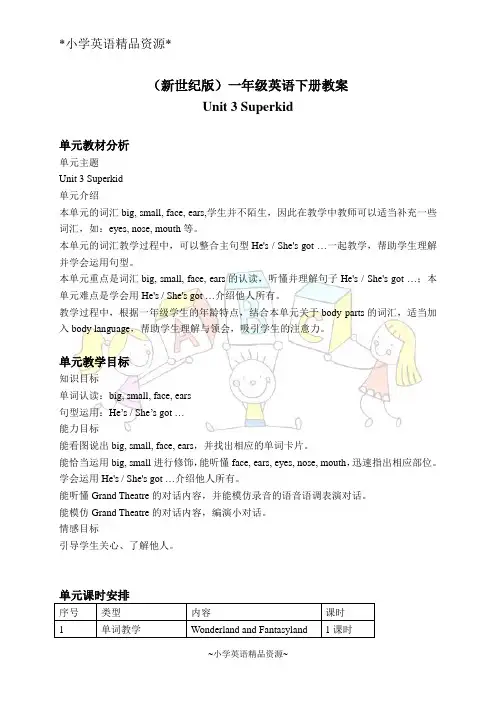
(新世纪版)一年级英语下册教案Unit 3 Superkid单元教材分析单元主题Unit 3 Superkid单元介绍本单元的词汇big, small, face, ears,学生并不陌生,因此在教学中教师可以适当补充一些词汇,如:eyes, nose, mouth等。
本单元的词汇教学过程中,可以整合主句型He's / She's got …一起教学,帮助学生理解并学会运用句型。
本单元重点是词汇big, small, face, ears的认读,听懂并理解句子He's / She's got …;本单元难点是学会用He's / She's got …介绍他人所有。
教学过程中,根据一年级学生的年龄特点,结合本单元关于body parts的词汇,适当加入body language,帮助学生理解与领会,吸引学生的注意力。
单元教学目标知识目标单词认读:big, small, face, ears句型运用:He’s / She’s got …能力目标能看图说出big, small, face, ears,并找出相应的单词卡片。
能恰当运用big, small进行修饰,能听懂face, ears, eyes, nose, mouth,迅速指出相应部位。
学会运用He's / She's got …介绍他人所有。
能听懂Grand Theatre的对话内容,并能模仿录音的语音语调表演对话。
能模仿Grand Theatre的对话内容,编演小对话。
情感目标引导学生关心、了解他人。
序号类型内容课时1 单词教学Wonderland and Fantasyland 1课时2 句型教学Grand Theatre 1课时第1课时:学生准备:了解一些body parts的单词。
教师准备:PPT演示文稿制作、一个洋娃娃、单词卡片、歌曲Head and Shoulders教学目标:1.知识目标能看图说出big, small, face, ears,并找出相应的单词卡片。
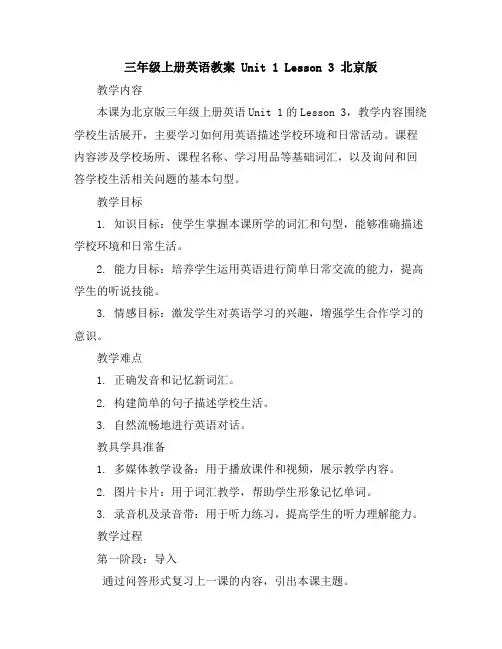
三年级上册英语教案 Unit 1 Lesson 3 北京版教学内容本课为北京版三年级上册英语Unit 1的Lesson 3,教学内容围绕学校生活展开,主要学习如何用英语描述学校环境和日常活动。
课程内容涉及学校场所、课程名称、学习用品等基础词汇,以及询问和回答学校生活相关问题的基本句型。
教学目标1. 知识目标:使学生掌握本课所学的词汇和句型,能够准确描述学校环境和日常生活。
2. 能力目标:培养学生运用英语进行简单日常交流的能力,提高学生的听说技能。
3. 情感目标:激发学生对英语学习的兴趣,增强学生合作学习的意识。
教学难点1. 正确发音和记忆新词汇。
2. 构建简单的句子描述学校生活。
3. 自然流畅地进行英语对话。
教具学具准备1. 多媒体教学设备:用于播放课件和视频,展示教学内容。
2. 图片卡片:用于词汇教学,帮助学生形象记忆单词。
3. 录音机及录音带:用于听力练习,提高学生的听力理解能力。
教学过程第一阶段:导入通过问答形式复习上一课的内容,引出本课主题。
利用图片展示学校环境,激发学生的兴趣。
第二阶段:新授通过多媒体展示新词汇,教师领读并解释词义。
学生跟读,模仿发音,教师纠正发音错误。
引导学生用新词汇造句,巩固记忆。
第三阶段:练习进行听力练习,学生听录音并选择正确的图片。
小组活动,用英语描述各自的学校生活。
第四阶段:巩固教师提出问题,学生用英语回答。
学生上台表演,模拟学校生活场景。
教师与学生一起回顾本课所学内容。
强调重点词汇和句型。
板书设计1. 课程Unit 1 Lesson 3 School Life2. 重点词汇:classroom, library, math, English, schoolbag 等。
3. 句型: What do you have in your schoolbag? I have作业设计1. 听力作业:听录音,完成相关练习。
2. 口语作业:与家长或同学用英语描述学校生活。
3. 写作作业:用英语写一段关于学校生活的短文。
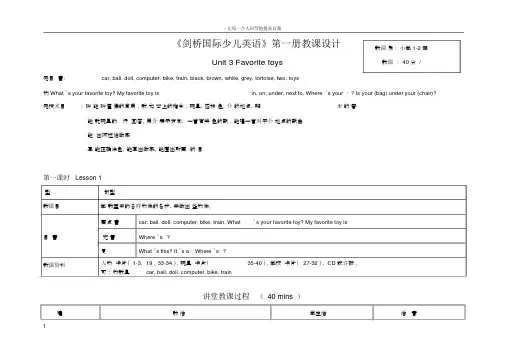
- 让每一个人同等地提高自我《剑桥国际少儿英语》第一册教课设计Unit 3 Favorite toys 教课象 : 小学 1-2 年教课: 40 分 /元目言:car, ball, doll, computer, bike, train, black, brown, white, grey, tortoise, two, toys构 What ’s your favorite toy? My favorite toy is⋯in, on, under, next to, Where’s your⋯ ? Is your (bag) under your (chair)?元技术目: 听能听懂候的常用,教和本上的指令,玩具,四种色,介的地点,辨/t/ 的音能就玩具的行回答,用介表示方向,一首有关色的歌,能唱一首对于介地点的歌曲能出阿拉伯数字写能正确涂色,能写出数字,能圈出所要的目第一课时Lesson 1型句型教课目学教室中的各样物件的名称,并数出些物件。
要点言car, ball, doll, computer, bike, train, What’s your favorite toy? My favorite toy is⋯目言充言Where ’s⋯ ?复What ’s this? It ’s a ⋯ Where ’s⋯ ?教课资料人物卡片( 1-3, 19 ,33-34 ),玩具卡片(35-40 ),学校卡片( 27-32 ), CD 或许磁,可:物教具car, ball, doll, computer, bike, train讲堂教课过程(40 mins)建教活学生活活意教课步Warm up / Lead in 1. 打招呼。
: Hello, ( 学生的名字 ),how are you? 学生回5 分答: I’m fine, thank you.被候的学生用同的方式其余人。
2. 展现人物卡片,学生和出人物的名字。
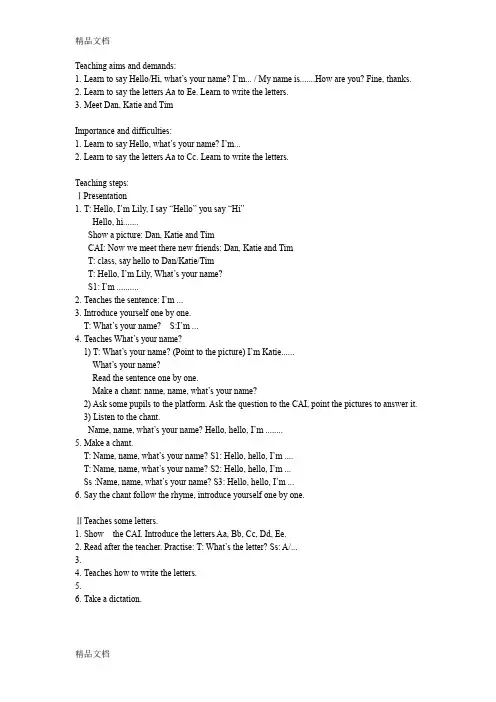
Teaching aims and demands:1.Learn to say Hello/Hi, what’s your name? I’m... / My name is.......How are you? Fine, thanks.2.Learn to say the letters Aa to Ee. Learn to write the letters.3.Meet Dan, Katie and TimImportance and difficulties:1.Learn to say Hello, what’s your name? I’m...2. Learn to say the letters Aa to Cc. Learn to write the letters.Teaching steps:ⅠPresentation1.T: Hello, I’m Lily, I say “Hello” you say “Hi”Hello, hi.......Show a picture: Dan, Katie and TimCAI: Now we meet there new friends: Dan, Katie and TimT: class, say hello to Dan/Katie/TimT: Hello, I’m Lily, What’s your name?S1: I’m ..........2.Teaches the sentence: I’m ...3.Introduce yourself one by one.T: What’s your name? S:I’m ...4.Teaches What’s your name?1) T: What’s your name? (Point to the picture) I’m Katie......What’s your name?Read the sentence one by one.Make a chant: name, name, what’s your name?2) Ask some pupils to the platform. Ask the question to the CAI, point the pictures to answer it.3) Listen to the chant.Name, name, what’s your name? Hello, hello, I’m ........5.Make a chant.T: Name, name, what’s your name? S1: Hello, hello, I’m ....T: Name, name, what’s your name? S2: Hello, hello, I’m ...Ss :Name, name, what’s your name? S3: Hello, hello, I’m ...6.Say the chant follow the rhyme, introduce yourself one by one.ⅡTeaches some letters.1.Show the CAI. Introduce the letters Aa, Bb, Cc, Dd, Ee.2.Read after the teacher. Practise: T: What’s the letter? Ss: A/...3.4.Teaches how to write the letters.5.6.Take a dictation.试讲与家长沟通发言稿一、二、介绍教材本课程选择的教材是亚历山大编写的新世纪少儿英语,这本教材的编者也编写了新概念英语,所以可以说这本教材是新概念英语的起点教材,与新概念英语有很多地方类似,对于孩子们以后上新概念英语也起了一个衔接任用。
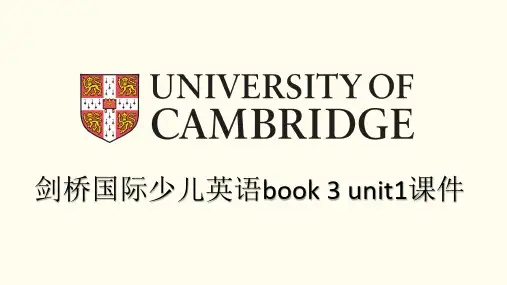
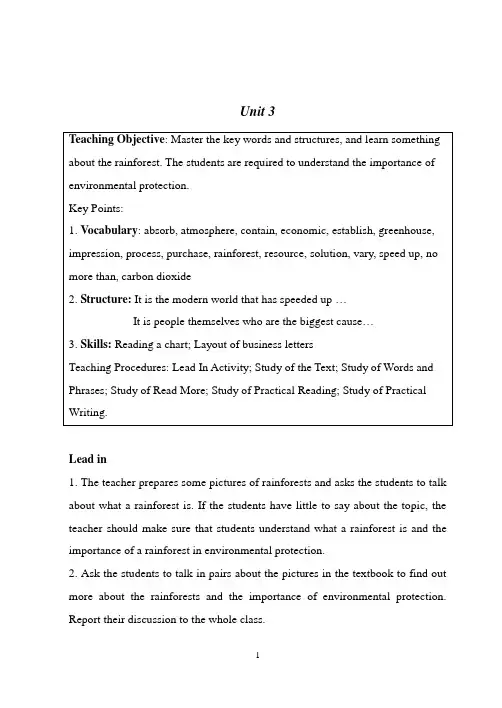
Unit 3Lead in1. The teacher prepares some pictures of rainforests and asks the students to talk about what a rainforest is. If the students have little to say about the topic, the teacher should make sure that students understand what a rainforest is and the importance of a rainforest in environmental protection.2. Ask the students to talk in pairs about the pictures in the textbook to find out more about the rainforests and the importance of environmental protection. Report their discussion to the whole class.Read InI. Background Information1. Paradise LostThe original title Paradise Lost refers to the masterpiece of the English poet John Milton(1608~1674) and one of the greatest poems in world literature. It tells the story of Satan’s rebellion against God and his expulsion from heaven and subsequent temptation and expulsion of Adam and Eve from the Garden of Eden. Here the author borrows Milton’s title for his own purpose.2. RainforestA rainforest is a piece of tropical woodland, characterized by lush vegetation and great biological diversity. There are more species of plants and animals in tropical rain forests than in all the rest of the world’s ecosystems combined. About 70 percent of all plant species in these forests are trees.3. Christopher Columbus: an Italian-born Spanish navigator who sailed west across the Atlantic Ocean in search of a route to Asia but achieved fame by finding the South American mainland.4. AmazonThe Amazon is a river in northern South America, largely in Brazil, raked as the largest in the world in terms of watershed area, number of tributaries, and volume of water discharged. Measuring about 6275 km from source to mouth, it is second in length only to the Nile among the rivers of the world.Topic-related words or phrasesDeforestation: particularly in the tropical rain forests, has become a majorenvironmental concern, as it can destabilize the earth’s temperature, humidity, and carbon dioxide level.Ecology: each ecosystem consists of a community of plants and animals in an environment that supplies them with raw materials for life, i.e. chemical elements and water.El Niño: originally was used to describe the warm southward current that appears in the region every December, but it is now reserved for occurrences that are exceptionally intense and persistent. These occur every three to seven years and can affect climates around the world for more than a year. The name El Niño, Spanish for “the child,” refers to the infant Jesus Christ and is applied because the current usually begins during the Christmas season.global warming: the gradual increase of the temperature of the earth’s lower atmosphere as a result of the increase in greenhouse gases since the Industrial Revolution. Visible, shortwave light comes from the sun to the earth, passing unimpeded through a blanket of thermal, or greenhouse, gases composed largely of water vapor, carbon dioxide, methane(沼气), nitrous oxide(一氧化二氮), and ozone(臭氧). Infrared radiation(红外辐射线) reflects off the planet’s surface toward space but does not easily pass through the thermal blanket. Rainforest: tree bush, grass, animal, bird, stream, fertile soilAnimals: tiger, lion, elephant, monkey, wolf, leopard, deer, bear, wild boar(野猪)Birds: swallow, duck, pheasant(野鸡), quail(鹌鹑), sparrow, hawk, crow, parrot, eagleII. Study of the TextRead In QuestionsRainforests are one of the most valuable natural gifts in the world, but now they are dying out. What has happened?A: People have been destroying rainforests as they have been seeking land under the trees, and modern technology available to human beings has sped up the process of such destructionComprehension Questions1.What does the sentence “It remains hard to beat.” mean? (L5)A: It means that no one else has ever given a better description of the rainforest than Columbus.2.What does the word “fragile” mean here? (L6)A: It means that the beauty is easy to be destroyed.3.What are the oldest communities of living things on the earth?A: In the author’s view, the rainforests are the oldest.4.Who should be responsible for the destruction of rainforests?A: It is the human beings that should be responsible for the destruction.5. What should be done to prevent the rainforests from complete ?A: People should pay enough attention to the environmental problems. First, they should purchase renewable rainforest products, and demand sustainable harvesting of rainforest resources. Then people should take stronger measures to prevent soil erosion and water losses.Language Points (T explains first, then gives Ss Chinese and asks Ss to translate them into English)1. Rainforests are extraordinarily beautiful, but the beauty is fragile.extraordinarily: beyond what is ordinarye.g. We found him extraordinarily well informed on political affairs.He spoke in a low voice and was extraordinarily polite.fragile: easily destroyed, not likely to laste.g. The vase is fragile, so handle it carefully.Their happiness was very fragile.2. It is the modern world that has speeded up the process of destruction.speed up: make go fastere.g. The car speeded up when it reached the county.We’d better speed up or we will be late for class.The director wants us to peed up the production of the new brand car.3. It is people themselves who are the biggest cause of destruction.(a structure expressing emphasis)e.g. It is me that he blamed.It was for you that I said all this.It was not until yesterday that I got the letter.It was Peter who lent us the money.4. Worse still, the climate is likely to change as the trees are no longer there to absorb.worse still: severer than; much worse thane.g. We lost our way in the forest. Worse still, night began to fall.He may be late or, worse still, he may not come at all.Jim was ill those days. And worse still, he was out of a job.Tom was late for class. And worse still, he forgot to bring his textbook withhim.5. The gas rises and traps the sun’s heat in much the same way as the glass of a greenhouse, leading to a slow but steady build-up of temperature.trap: prevent sb. or sth. from leaving or getting oute.g. The robbers were trapped in the bank.A filter traps dust from the air.Making SentencesI made a bad impression on the teacher by being late for class on the first day. Joan has no more than 1 yuan on her, so she can’t afford a meal.The local government has come to realize the importance of sustainable development.In China, it is unlawful to cut down the trees without permission.These years, the rate of interest always varies between 4% and 6%.The number of rooms in their hotel is the same as ours.Paraphrases of Difficult SentencesLines 31~33: “The gas rises and traps the sun’s heat in much the same way at the glass of a greenhouse, leading to a slow but steady build-up of temperature.”●The gas of carbon dioxide in the air absorbs the heat of the sun just as aglass greenhouse does in a sunny day, thus increasing the global temperature over the years.Lines 37~39: “On the other hand, by purchasing renewable rainforest products, and demanding sustainable harvesting of rainforest resources, we all can be part of the solution and it is human beings that will be saved.”●On the other hand, if we buy recyclable wood products and insist on a typeof inexhaustible rainforest resources for repeated uses, we are then already part of the solution to the problem of rainforests and we human beings will be saved.Summary of the TextOnce the most beautiful and oldest communities of living things on the earth, rainforests are now being destroyed. The first cause of the destruction has been men’s craziness for land, while the modern technology available to people has sped up the horrible process of such destruction. Worse still, the shrinkage of rainforests has disastrously led to the shortage of water sources and the warming-up of global temperature. Nevertheless, there is still hope for a solution to this problem if human beings will take some preventive measures.Read afterI. Study of the Words and PhrasesE-E: When T says a word or an expression you’ve learned before, Ss respond with the new one in this text.an extremely pleasant, beautiful place: paradisethe opinion or feeling you have about sb. or sth.: impressiona tropical forest with tall trees: rainforestvery unusual or surprising: extraordinaryeasily damaged, spoilt, or destroyed: fragileinclude: containset up, or found: establishthe process of destroying sth.: destructiontake in: absorbaway o fsolving a problem: solutioncontinue to be in the same state or condition: remainsay that sb. is responsible for sth.: blamegather in crops: harvestvery big: giantbuy something: purchasebe different from each other: varyland, mineral, or natural energy that exists in a country: natural resources only, just: no more thanmove or happen faster: speed upcut a tree so that it falls: cut downcarry away with liquid: wash awaywhat is even worse: worse stillmake money by selling or doing business: make profitsnot like sth. or sb.: different frombe made to do sth. they do not want to: be forced to do sth.be probably: be likely to donot any more: no longerresult in: lead toa possible method of solving a problem: the way outC-E: when T says a phrase or an expression in Chinese, Ss try to find the English equivalent learnt in the text.最早的文字描述:the first known written description异常美丽:extraordinarily beautiful最古老的群居生物:the oldest communities of living things生物物种:living species亚马逊盆地:the Amazon basin需要很长时间才能重新长成:take a long time to come back减少:come down次生林:the secondary growth加快进程:speed up the process一群人:a team of men最大的破坏根源:the biggest cause of destruction占有最好的土地:own the best land被迫去做:be forced to do冲走:wash away更糟糕的是:worse still吸收大气层中的二氧化碳:absorb the carbon dioxide in the atmosphere 吸收太阳的热量:trap the sun’s heat气温缓慢而稳定地回升:a slow but steady built-up of temperature养家:feed one’s family赚钱:make profits可再生的产品:renewable products出路:the way out消逝:die outOral Discussion:What are our solutions to environmental problems?Read More Ss read the two passages and find their topic sentences.Homework Ss use at least 10 of above words & phrases to write an article about environment or a summary of the text.。
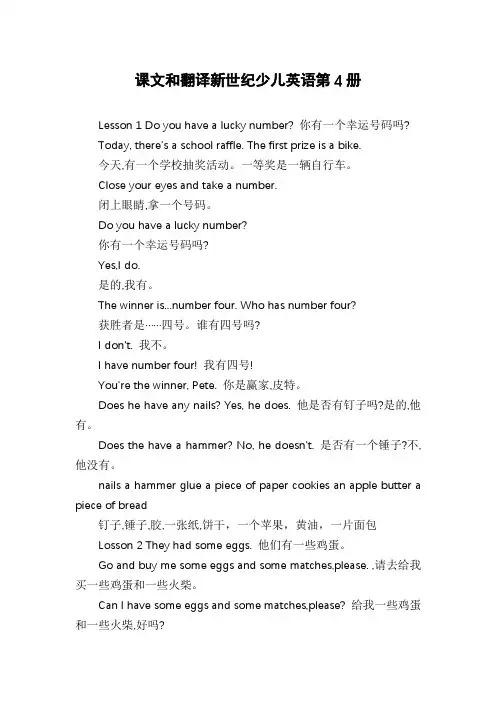
课文和翻译新世纪少儿英语第4册Lesson 1 Do you have a lucky number? 你有一个幸运号码吗?Today, there’s a school raffle. The first prize is a bike.今天,有一个学校抽奖活动。
一等奖是一辆自行车。
Close your eyes and take a number.闭上眼睛,拿一个号码。
Do you have a lucky number?你有一个幸运号码吗?Yes,I do.是的,我有。
The winner is...number four. Who has number four?获胜者是……四号。
谁有四号吗?I don't. 我不。
I have number four! 我有四号!You're the winner, Pete. 你是赢家,皮特。
Does he have any nails? Yes, he does. 他是否有钉子吗?是的,他有。
Does the have a hammer? No, he doesn't. 是否有一个锤子?不,他没有。
nails a hammer glue a piece of paper cookies an apple butter a piece of bread钉子,锤子,胶,一张纸,饼干,一个苹果,黄油,一片面包Losson 2 They had some eggs. 他们有一些鸡蛋。
Go and buy me some eggs and some matches,please. ,请去给我买一些鸡蛋和一些火柴。
Can I have some eggs and some matches,please? 给我一些鸡蛋和一些火柴,好吗?Sorry.I have some eggs,but I don't have any matches. 对不起。
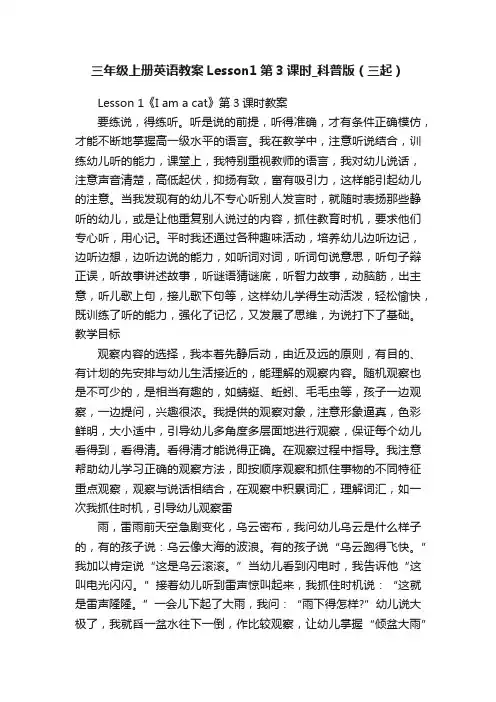
三年级上册英语教案Lesson1第3课时_科普版(三起)Lesson 1《I am a cat》第3课时教案要练说,得练听。
听是说的前提,听得准确,才有条件正确模仿,才能不断地掌握高一级水平的语言。
我在教学中,注意听说结合,训练幼儿听的能力,课堂上,我特别重视教师的语言,我对幼儿说话,注意声音清楚,高低起伏,抑扬有致,富有吸引力,这样能引起幼儿的注意。
当我发现有的幼儿不专心听别人发言时,就随时表扬那些静听的幼儿,或是让他重复别人说过的内容,抓住教育时机,要求他们专心听,用心记。
平时我还通过各种趣味活动,培养幼儿边听边记,边听边想,边听边说的能力,如听词对词,听词句说意思,听句子辩正误,听故事讲述故事,听谜语猜谜底,听智力故事,动脑筋,出主意,听儿歌上句,接儿歌下句等,这样幼儿学得生动活泼,轻松愉快,既训练了听的能力,强化了记忆,又发展了思维,为说打下了基础。
教学目标观察内容的选择,我本着先静后动,由近及远的原则,有目的、有计划的先安排与幼儿生活接近的,能理解的观察内容。
随机观察也是不可少的,是相当有趣的,如蜻蜓、蚯蚓、毛毛虫等,孩子一边观察,一边提问,兴趣很浓。
我提供的观察对象,注意形象逼真,色彩鲜明,大小适中,引导幼儿多角度多层面地进行观察,保证每个幼儿看得到,看得清。
看得清才能说得正确。
在观察过程中指导。
我注意帮助幼儿学习正确的观察方法,即按顺序观察和抓住事物的不同特征重点观察,观察与说话相结合,在观察中积累词汇,理解词汇,如一次我抓住时机,引导幼儿观察雷雨,雷雨前天空急剧变化,乌云密布,我问幼儿乌云是什么样子的,有的孩子说:乌云像大海的波浪。
有的孩子说“乌云跑得飞快。
”我加以肯定说“这是乌云滚滚。
”当幼儿看到闪电时,我告诉他“这叫电光闪闪。
”接着幼儿听到雷声惊叫起来,我抓住时机说:“这就是雷声隆隆。
”一会儿下起了大雨,我问:“雨下得怎样?”幼儿说大极了,我就舀一盆水往下一倒,作比较观察,让幼儿掌握“倾盆大雨”这个词。
《剑桥国际少儿英语》Unit 1 Hello!单元目标语言:语词red, yellow, pink, green, orange, purple, blue, monster, rainbow, and, 数字 1-10,发音/s/结构Hello, I’m… Goodbye, What’s your name? How old are you? What color’s (the crayon)? It’s (red).单元技能目标: 听 能够听懂打招呼、问候的常用语,教师和课本上的指令语,能辨别/s/的发音说 能够自我介绍,能就年龄进行提问和回答,能连续数1-10的数字,能谈论颜色并唱一首颜色的歌曲读 能认读出阿拉伯数字写 能正确涂色,能用数字写出自己的年龄第一课时 Lesson 1第二课时Lesson 2第三课时Lesson 3第四课时Lesson 4第五课时Lesson 5第六课时Lesson 6Our World Review Units 1-4单元目标语言:语词家庭,形容词,介词,玩具,教室物品,颜色,数字,人物和玩具名字,课堂用语,发音/s//m//t//b/ 结构to be, 疑问句单元技能目标: 听能够听懂问候的常用语,教师和课本上的指令语,家庭成员的名称和所表达的关系,形容词,介词,玩具,教室物品,颜色,数字,人物和玩具名字,辨别/s//m//t//b/的发音说能够就家庭,形容词,介词,玩具,教室物品,颜色,数字,人物和玩具名字,课堂用语进行简单回答,能唱关于颜色,数字,教室物品,玩具,介词,家庭成员和形容词的歌曲歌谣读能认读出阿拉伯数字和发音/s//m//t//b/写能正确涂色,能写出数字,能圈出所要选择的项目第一课时Lesson 1第二课时Lesson 2Unit 2 My School!单元目标语言:语词table, book, chair, eraser, pen, pencil, your, puppet, monkey, mouse, 发音/m/结构Is this a (pen)? Yes/No, Who’s that? Who’s he/she? How old are you? How old is he/she? He/She is (7). How are you?I’m fine, thank you.单元技能目标: 听能够听懂打招呼、问候的常用语,教师和课本上的指令语,教室物品单词的单复数发音,能辨别/m/的发音说能够就他人年龄进行提问和回答,能谈论教室物品,简单回答问题,并说一首有关教室物品的歌谣,能唱一首问候的歌曲读能认读出阿拉伯数字写能正确涂色,能写出数字第一课时Lesson 1第二课时Lesson 2第三课时Lesson 3第四课时Lesson 4第五课时Lesson 5第六课时Lesson 6Unit 3 Favorite toys单元目标语言:语词car, ball, doll, computer, bike, train, black, brown, white, grey, tortoise, two, toys结构What’s your favorite toy? My favorite toy is… in, on, under, next to, Where’s your…? Is your (bag) under your (chair)? 单元技能目标: 听能够听懂问候的常用语,教师和课本上的指令语,玩具,四种颜色,介词的位置,辨别/t/的发音说能够就玩具的话题进行简单回答,用介词表示方位,说一首有关颜色的歌谣,能唱一首关于介词位置的歌曲读能认读出阿拉伯数字写能正确涂色,能写出数字,能圈出所要选择的项目第一课时Lesson 1第二课时Lesson 2第三课时Lesson 3第四课时Lesson 4第五课时Lesson 5第六课时Lesson 6Unit 4 My Family单元目标语言:语词family, mother, father, brother, sister, grandmother, grandfather, box, old, young, happy, sad, beautiful, ugly, Bertie Bat结构Who’s that? We’re (young).单元技能目标: 听能够听懂问候的常用语,教师和课本上的指令语,家庭成员的名称和所表达的关系,形容词,辨别/b/的发音说能够就家庭成员的话题进行简单回答,用形容词描述人物,能唱一首关于家庭成员和形容词的歌曲读能认读出阿拉伯数字写能正确涂色,能写出数字,能圈出所要选择的项目第一课时Lesson 1第二课时Lesson 2第三课时Lesson 3第四课时Lesson 4第五课时Lesson 5第六课时Lesson 6Unit 5 Our Pets单元目标语言:语词cat, dog, fish, horse, mouse, bird, (red) and (blue), long, short, big, small, clean, dirty, Penny Penguin,发音/p/ 结构They’re (ugly/big),复数单元技能目标: 听能够听懂问候的常用语,教师和课本上的指令语,宠物的名称,形容词,辨别/p/的发音说能够就宠物的话题进行简单回答,用形容词描述宠物,能说唱歌谣、歌曲读能认读部分颜色、数字、形容词的单词,全部宠物的单词写能正确涂色,能写出数字,能圈出所要选择的项目,能抄写部分宠物和形容词的单词第一课时Lesson 1第二课时Lesson 2第三课时Lesson 3第四课时Lesson 4第五课时Lesson 5第六课时Lesson 6Our World Review Units 5-8单元目标语言:语词衣服,野生动物,脸和身体,宠物,家庭,形容词,介词,玩具,教室物品,颜色,数字,人物和玩具名字,课堂用语,发音/p//h//k//d/ 结构to be, 疑问句, have got单元技能目标: 听能够听懂问候的常用语,教师和课本上的指令语,衣服,野生动物,脸和身体,宠物,辨别/p/ /h/ /k/ /d/的发音说能够就衣服,野生动物,脸和身体,宠物进行简单回答,能说唱关于衣服,野生动物,脸和身体,宠物的歌曲歌谣读能认读出衣服,野生动物,脸和身体,宠物的单词,和部分家庭,形容词,玩具,教室物品,颜色,数字的单词,字母Aa-Pp,首字母发音为/s//m//t//b/的单词写能正确涂色,能写出数字,能圈出所要选择的项目,抄写衣服,野生动物,脸和身体,宠物的单词,和字母Aa-Pp(大小写)第一课时Lesson 1第二课时Lesson 2Unit 6 My Face单元目标语言:语词face, ear, eye, mouth, nose, teeth/tooth, hair, head, shoulders, knees, toes, body, Henry horse, 发音/h/ 结构Have you got a (small mouth)? Yes, (I have). No, I haven’t. I’ve got (purple hair). We’ve got (six dirty ears).单元技能目标: 听能够听懂问候的常用语,教师和课本上的指令语,脸和身体部位的名称,辨别/p/的发音说能够就脸和身体部位进行简单回答,能说唱歌谣、歌曲读能认读全部脸部部位的单词和部分颜色、数字、身体部位和形容词的单词写能正确涂色,能写出数字,能圈出所要选择的项目,能抄写全部脸部部位的单词和部分脸和身体部位的单词第一课时Lesson 1第二课时Lesson 2第三课时Lesson 3第四课时Lesson 4第五课时Lesson 5第六课时Lesson 6Unit 7 Wild animals单元目标语言:语词crocodile, elephant, hippo, giraffe, snake, tiger, animal, arm, leg, tail, foot/feet, hand, Cassandra cat, 发音/k/ 结构They’ve got (big mouths). They haven’t got (tails). Have they got (long legs)? How many (teeth) have they got?单元技能目标: 听能够听懂问候的常用语,教师和课本上的指令语,野生动物、身体部位的名称,辨别/k/的发音说能够就野生动物、脸和身体部位进行简单回答,能说唱歌谣、歌曲读能认读全部野生动物的单词,部分身体部位、颜色、数字和形容词的单词写能正确涂色,能写出数字,能圈出所要选择的项目,能抄写全部野生动物的单词和部分身体部位的单词第一课时Lesson 1第二课时Lesson 2第三课时Lesson 3第四课时Lesson 4第五课时Lesson 5第六课时Lesson 6Unit 8 My clothes单元目标语言:语词jacket, shoes, skirt, socks, (pair of ) trousers, T-shirt, Daisy dog, 发音/d/ 结构He’s/She’s got…, He/She hasn’t got…单元技能目标: 听能够听懂问候的常用语,教师和课本上的指令语,服装的名称,辨别/d/的发音说能够就服装进行简单回答,能说唱歌谣、歌曲读能认读全部服装的单词,部分颜色、数字和形容词的单词写能正确涂色,能写出数字,能圈出所要选择的项目,能抄写全部服装的单词第一课时Lesson 1第二课时Lesson 2第三课时Lesson 3第四课时Lesson 4第五课时Lesson 5第六课时Lesson 6Unit 9 Fun time!单元目标语言:语词play football, play basketball, play tennis, play the guitar, play the piano, swim, ride a bike, ride a horse, sing, fish, dive a car, Freddy Frog发音/f/结构I, You, He, She can/can’t… What can you do? Can you (fish)?单元技能目标: 听能够听懂问候的常用语,教师和课本上的指令语,体育运动和活动的名称,辨别/f/的发音说能够讨论体育运动和活动,能说唱歌谣、歌曲读能认读体育运动和活动的短语写能正确涂色,能写出数字,能圈出所要选择的项目,能抄写体育运动和活动的短语第一课时Lesson 1第二课时Lesson 2第三课时Lesson 3第四课时Lesson 4第五课时Lesson 5第六课时Lesson 6。
1 / 23《剑桥国际少儿英语》第一册教案Unit 1 Hello!单元目标语言:语词red, yellow, pink, green, orange, purple, blue, monster, rainbow, and, 数字 1-10,发音/s/ 结构Hello, I’m… Goodbye, What’s your name? How old are you? What color’s <the crayon>? It’s <red>. 单元技能目标: 听能够听懂打招呼、问候的常用语,教师和课本上的指令语,能辨别/s/的发音 说能够自我介绍,能就年龄进行提问和回答,能连续数1-10的数字,能谈论颜色并唱一首颜色的歌曲 读能认读出阿拉伯数字写能正确涂色,能用数字写出自己的年龄第一课时 Lesson 1课堂教学过程 〔40 mins 〕2 / 23第二课时Lesson 2课堂教学过程〔40 mins〕5 / 236 / 237 / 23第三课时Lesson 3课堂教学过程〔40 mins〕8 / 239 / 2310 / 23第四课时Lesson 411 / 23课堂教学过程〔40 mins〕12 / 2313 / 2314 / 23第五课时Lesson 515 / 23课堂教学过程〔40 mins〕16 / 2317 / 2318 / 23第六课时Lesson 640 mins〕课堂教学过程〔19 / 2320 / 2321 / 2322 / 2323 / 23。